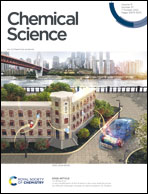Calix[4]pyrrolato gallate: square planar-coordinated gallium(iii) and its metal–ligand cooperative reactivity with CO2 and alcohols†
Abstract
Forcing a priori tetracoordinate atoms into planar configuration represents a promising concept for enhanced reactivity of p-block element-based systems. Herein, the synthesis, characterization, and reactivity of calix[4]pyrrolato gallates, constituting square planar-coordinated gallium(III) atoms, are reported. Unusual structural constraint-induced Lewis acidity against neutral and anionic donors is disclosed by experiment and rationalized by computations. An energetically balanced dearomatization/rearomatization of a pyrrole unit enables fully reversible metal–ligand cooperative capture of CO2. While alcohols are found unreactive against the gallates, a rapid and selective OH-bond activation can be triggered upon protonation of the ligand. Secondary ligand–sphere modification adds a new avenue to structurally-constrained complexes that unites functional group tolerance with unconventional reactivity.
![Graphical abstract: Calix[4]pyrrolato gallate: square planar-coordinated gallium(iii) and its metal–ligand cooperative reactivity with CO2 and alcohols](/en/Image/Get?imageInfo.ImageType=GA&imageInfo.ImageIdentifier.ManuscriptID=D2SC03054C&imageInfo.ImageIdentifier.Year=2022)


 Please wait while we load your content...
Please wait while we load your content...